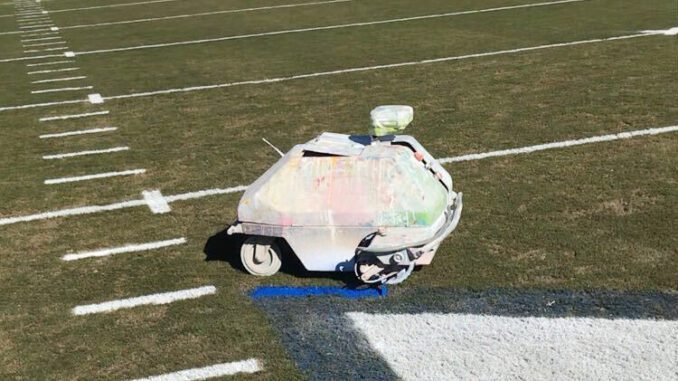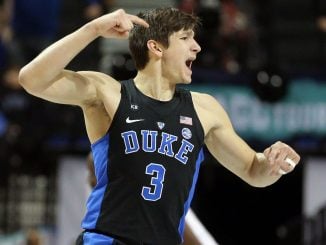
DURHAM — A few days before Duke’s final home game of the football season, the grounds and facilities crew was busy getting the field ready.
While one group of three men, lugging plenty of equipment, were working to paint part of one end zone dark blue, Sergei headed out to midfield to make the large D logo.
Sergei was responsible for all the yard lines and hash marks, which had been painted on the field the day before. He finished in under four hours. Before he arrived at Duke, it took the three-man team all day to finish the job.
“The hash marks are the tough part,” said Cooper Boyce, a first-year landscape specialist at Duke. He pointed at the little markings that needed to be placed every yard up and down the field on both sides. “The guys have a stencil, and they had to pick it up and move it to the right spot each time.” Keeping them straight and exactly a yard apart required them to go slowly.

Not Sergei, who has GPS satellites telling him just where to go and when to paint. Sergei is 18 inches tall, is completely covered with dried paint of varying shades and holds four and a half gallons of paint. He came with a price tag of $43,000, plus an ongoing subscription fee.
Sergei is a GPS field-painting robot who has been putting paint on grass for Duke for the last few years. He was produced by Turf Tank, a Danish company that has changed the way teams prepare fields. Turf Tank’s programmers develop GPS instructions for the robot to follow. A quick scan of the programs available shows that Sergei can paint any number of Duke’s athletic fields — he would be doing the soccer field later in the week. He can also do a variety of logos, including Duke’s gothic D, their Hellraiser devil’s head logo and the ACC conference logo.
“He also did the big, pink breast cancer ribbon on the lawn in front of the hospital,” Boyce said.
Sergei looks like a small tank and operates like a cross between a Roomba and an old-school jet printer. It rolls around the field, spraying paint from a nozzle located on one side. It can do the straight lines required to make the gridiron of yard lines and can also do the curves required by the capital D and the C’s in the league logo.
It generally paints one line at a time, then keeps going in that direction for a few feet before making a small loop and adjusting its angle for the next line.
The one minor inconvenience with Sergei is that he doesn’t always know when paint is still wet.
“After painting the NCAA logo on the soccer field last week, he accidentally drove through itself a bunch of times,” Boyce said. “We had to go out there with buckets of water and clean it up, blade (of grass) by blade.”
As a result, one of Boyce’s responsibilities, in addition to choosing the program from a tablet that controls Sergei, is to follow the robot around with a pair of towels, so he can cover the newly painted lines that Sergei might roll over on his way to the next step in the design.
For the purposes of time, Duke tends to rely on Sergei to do the line drawing, while the humans often handle the larger patches of color. As Sergei moved on from outlining the D at midfield to drawing the ACC logos, a human member of the grounds crew came over to paint the interior of the D blue.
“He can go faster because the outline gives him some leeway,” Boyce explained. Without the outline, it would require three people — one to paint and two to set up wooden barricades on either side to make sure stray paint doesn’t go onto the areas of the field that need to be white or remain green. This method appears to be more like coloring inside the lines.
“Exactly,” Boyce agreed.
Sergei can do large fields of color, like end zones or yard-line numbers. It just takes a bit longer. “It’ll do like a dot matrix,” Boyce explained. “Like an old printer, basically. And it will start in the middle of the logo and work its way out. That’s how we did the pink ribbon.”
Duke was one of Turf Tank’s first collegiate customers.
“This is the original,” Boyce said. “Ours still has ‘demo’ written on a bunch of it.”
The rest of college athletics is catching on, however.
“I know almost all the SEC schools have them,” Boyce said. “Virginia’s got one. (NC) State’s getting one. Clemson has one, I believe. I just saw the other day that the company has sold its 1,000th robot.”
So, while a three-person team lugged an air compressor and wooden barricades through the Duke end zone, Sergei continued its dance at midfield, painting and looping his way through various logos and taking athletic landscaping into the future.
Just make sure to have a couple of towels handy.



